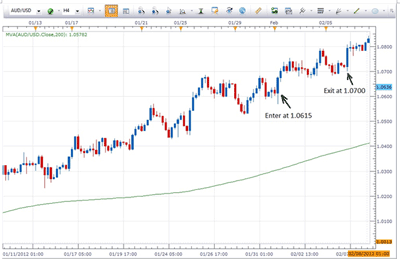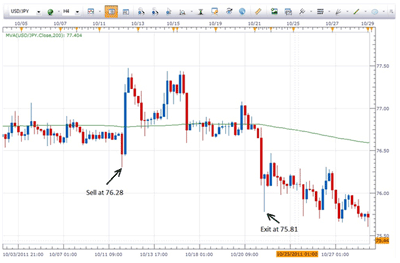Richard Krivo of DailyFX.com explains how currency pairs are traded in tandem and how pips are the measure of gain or loss in forex trading.
Trading the forex market centers around the basic concepts of buying and selling.
Let's take the idea of buying first. What if you bought something (it could literally be almost anything: a house, a piece of jewelry, a stock, etc.) and it went up in value. If you sold it at that point, you would have made a profit: the difference between what you paid originally and the greater value that the item is worth now.
Currency trading works the same way.
Let's say you want to buy
the AUD/USD currency pair. If the Australian dollar (AUD) goes up in value
relative to the US dollar (USD) and then you sell it, you will have made a
profit. A trader in this example would be buying the AUD and selling the USD at
the same time.
For example, if the AUD/USD pair was bought at 1.0615 and the pair moved up to 1.0700 at the time that the trade was closed/exited, the profit on the trade would have been 85 pips (see the chart below).
Had the pair moved down to 1.0600 before the trade was closed, the loss on the trade would have been 40 pips.
See related: Why 90% of Forex Traders Lose Money
Also, it makes no difference which currency pair you are trading. If the price of the currency you are buying goes up from the time you bought it, you will have made a profit.
Here is another example using the AUD. In this case, we still want to buy the AUD, but let's do this with the EUR/AUD currency pair. In this instance, we would sell the pair. We would be selling the euro (EUR) and buying the AUD simultaneously. Should the AUD go up relative to the EUR, we would profit as we bought the AUD.
In this example, if we sold the EUR/AUD pair at 1.2320 and the price moved down to 1.2250 when we closed the position, we would have made a profit of 70 pips. Had the pair moved up instead and we closed out the position at 1.2360, we would have had a loss of 40 pips on the trade.
Remember, we are always buying or selling the currency on the left side of the pair. If we buy the currency on the left side, which is called the base currency, we are selling the one on the right side, which is called the cross, or counter currency. The opposite would be true if we were selling the currency on the left side.
NEXT: How to Profit by Selling a Currency Pair
|pagebreak|Now let's take a look at how a trader can make a profit by selling a currency pair. This concept is a little trickier to understand than buying. It is based on the idea of selling something that you borrowed as opposed to selling something that you own.
In the case of currency trading, when taking a sell position, you would borrow the currency in the pair that you were selling from your broker (this all takes place seamlessly within the trading station when the trade is executed), and if the price went down, you would then sell it back to the broker at the lower price. The difference between the price at which you borrowed it (the higher price) and the price at which you sold it back to them (the lower price) would be your profit.
For example, let's say a trader believes that the USD will go down relative to the Japanese yen (JPY). In this case, the trader would want to sell the USD/JPY pair. They would be selling the USD and buying the JPY at the same time.
See related: Intro to Trading the Japanese Yen
The trader would be borrowing the USD from their broker when they execute the trade. If the trade moved in their favor, the JPY would increase in value and the USD would decrease. At the point where they closed out the trade, their profits from the JPY increasing in value would be used to pay back the broker for the borrowed USD at the now-lower price. After paying back the broker, the remainder would be their profit on the trade.
For example, let's say the trader shorted the USD/JPY pair at 76.28. If the pair did in fact move down and the trader closed/exited the position at 75.81, the profit on the trade would be 47 pips.
On the other hand, if the pair was shorted at 76.28 and the pair did not move down, but rather moved up to 76.50 when the position was closed, there would be a loss on the trade of 22 pips.
In a nutshell, this how you can make a profit from selling something that you do not own.
In conclusion, if you buy a currency pair and it moves up, that trade would show a profit. If you sell a currency pair and it moves down, that trade would show a profit.
By Richard Krivo of DailyFX.com













